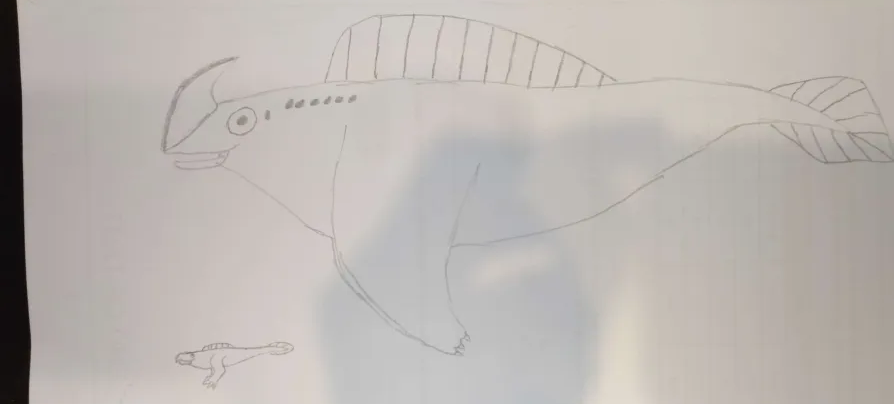HOME | DD
 ProjectMishmash — Ice breaker Landprey
ProjectMishmash — Ice breaker Landprey

#alien #aliencreature #alienspecies #astrobiology #creaturedesign #speculativeevolution #speculativebiology #speculativezoology
Published: 2024-03-20 20:34:54 +0000 UTC; Views: 1129; Favourites: 3; Downloads: 0
Redirect to original
Description
Submitted by The Weevil OverlordSize: 1 meter to 10 metres
Niche: Cat like niche when young (competes with Mołts) and Seal niche when adult
Planet of Origin: Icarrus
Description: This is the distant descendant of the millers lake lamprey, it is part of a group of Landpreys (the word landprey being a mix of land and lamprey) that have become secondarily aquatic again, the Landprey "jaw" was ancestrally it's "tongue" (the "tongue" being a similar structure but not sharing the same origin as other animals tongues), the "tongue" becoming a wide flat bony plate serving as a sort of lower jaw, they originally used this plate to scoop out chunks of flesh off of other creatures, as the ancestors came onto land, they used it as a proper lower jaw but kept their cartilage skeleton, being malleable and easily adapted into different niches, they adapted the odd "hip" structure within their body's as the base for a pair of legs, they developed water tight scales and their muscles work much like a spiders muscles, they have developed live birth but in typical Landprey fashion, they have evolved a novel way unseen in any other vertebrate. The females store fat in their tails, swelling up to double or triple its original width, the female then mates and produces a few eggs (1-13 are typical but vary between species, this particular species produces up to 6), unlike a regular lamprey, Landpreys keep the egg within the body, and the young will, once hatched, move out of the reproductive track and into the fatty tail (the female having evolved a sort of trapdoor that leads into the tail), The young then consume all the fat within the tail, if the female hasn't got a lot of fat within the tail then the young will cannibalize each other. The young are extremely primitive in appearance and in many ways show how the group evolved, they even retain their tongues, the young will slowly develop it's features, first it grows its tongue jaw, then it slowly develops it's legs and fins, once it has developed all it's features, it will then make its way back to the reproductive track (being just barely small enough to fit through), the female will then give birth to one or more precocial young that will leave the nest within a week. The young of this species is born and lives on land, over time it begins to live closer and closer to the rivers and the ocean, developing a much more aquatic biology, it will then transition into a full time marine creature and will be a adult, it uses its legs (which can be flattened via the scales and muscles) to swim and retains claws, useful to defend itself whilst on land, the male will follow the female onto land to compete, creating almost musical calls to attract females, this particular species lives in the polar oceans and has a crest adapted to break through ice when required, the young are born in the tropics and will slowly migrate to open water, They live worldwide across all of the continents, this species is perhaps the most behaviorally and biologically flexible creature and will likely continue for a very long time upon it's new world.
























